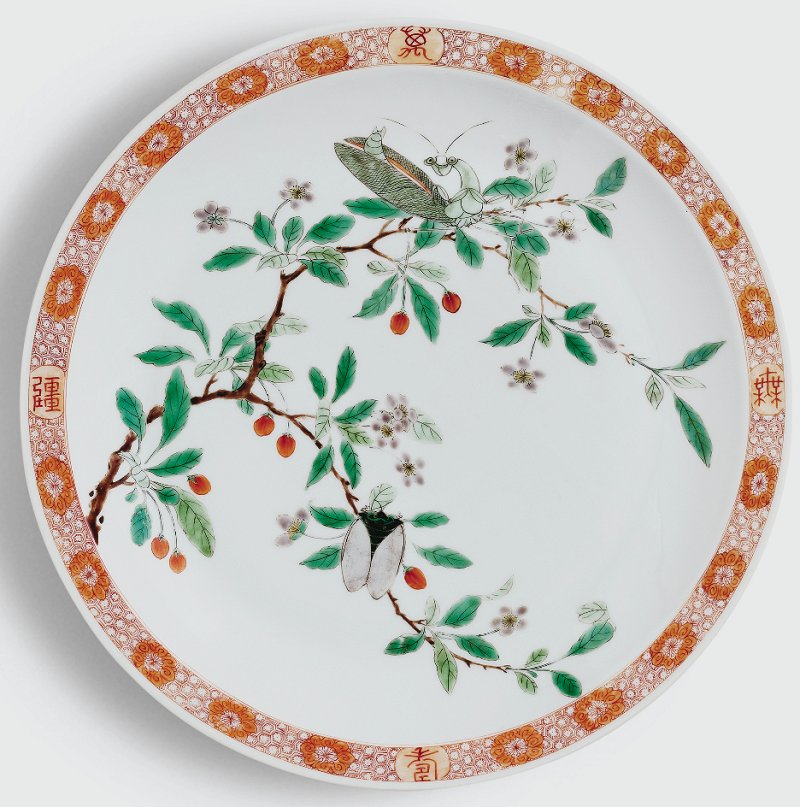
Dishes of this finely painted type, and inscribed with a wish for long life in the rim border, are believed to have been made for the Kangxi Emperor's sixtieth birthday in AD 1713. Provenance, The Meiyintang Collection, Sold at Sotheby's the 4 April, 2012, Hong Kong. Lot nr 19
When referred to, most often plates said to have been made in celebration of the sixtieth birthday of the Emperor Kangxi in 1713, are meant. In her presentations of the Percival David Foundation in London, Rosemary E. Scott have explained that the Birthday dish is a symbol of the Chinese respect for old age. The Confucian tenets of Chinese culture stressed not only the importance of filial piety (respect for one's parents) but also respect for the elderly in general. Both the Kangxi and Qianlong emperors reached sixty years of age and enjoyed great festivities.
So-called gray-beards' banquets were held in the imperial palace in Beijing, and old men were invited from all over China to attend. The first of these graybeards' banquets was held in the Garden of Joyous Spring in 1713 to celebrate the Kangxi emperor's sixtieth birthday, and another was held for his seventieth birthday in the Palace of Heavenly Purity. More than one thousand guests over the age of sixty-five attended these celebrations.
Despite their fragility, a number of these dishes survive. It seems likely that they were not actually used at the banquets but were among the presents given to the guests as tokens of imperial favor. As such they would probably have been presented in fitted boxes and handed down as treasured family heirlooms.
They are decorated with famille verte enamels on the medallion with different motifs such as a grasshopper above a beetle on fruit bearing flowering branches, geese, an eagle perched on the branch of a fruiting ginko tree, the bird naturalistic rendered with its head turned looking back over its shoulder with beady eyes, a bird perched on an apricot tree, and a pair of mandarin ducks swimming in a lotus pond, all surrounded with a border on the everted rim of floral blooms in iron red arranged on a honeycomb diaper-ground, evenly divided at the four cardinal points with archaistic seal script meaning Wan Shou Wu Jiang or "Longevity without an end". Sizes 9 7/8 - 10 in. (25.1 - 25.4 cm.) diameter.
Litterature and references
Anthony du Boulay, Christie's Pictorial History of Chinese Ceramics, London, 1984, p. 227, fig. 2.
Regina Krahl, Chinese Ceramics from the Meiyintang Collection, London, 1994-2010, vol. 4, no. 1727.
A dish with a grasshopper on a stem of peas, from the Bennett collection, is illustrated in W.G. Gulland, Chinese Porcelain, London, 1911, vol. II, pl. 635; another with a bee hovering around a flowering branch, from the collection of Donald S. Morrison, was sold at Christie's New York, 18th June 1980, lot 421.
'Birthday' dishes with four different motifs from the Sir Percival David Collection are in the British Museum, London, see Illustrated Catalogue of Qing Enamelled Wares in the Percival David Foundation of Chinese Art, rev. ed., London, 1991, nos. 812, 890, 891 and A 836; others with a bird on a fruiting branch are, for example, in the Musée Guimet, Paris, illustrated in Xavier Besse, La Chine des porcelaines, Paris, 2004, pl. 35; and in the Gulexuan collection, published in Regina Krahl with Clarissa von Spee, Chinese Ceramics from the Gulexuan Collection, Lünen, 2003, pl. 99 and illustrated also on the dust jacket.
A